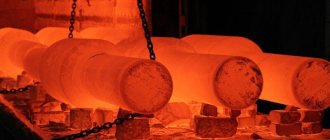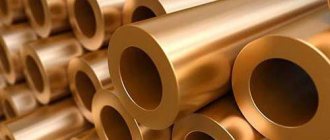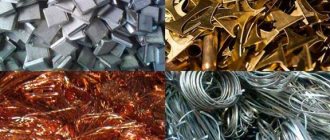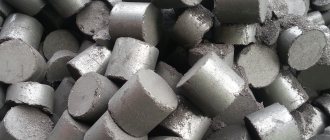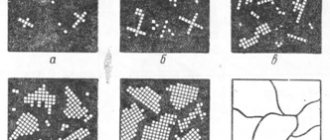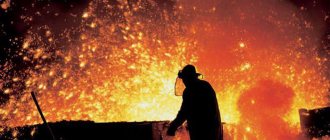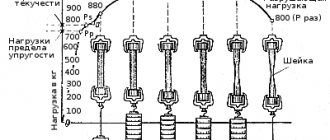Man began working with metals in the 4th millennium. In history, centuries of acquaintance with new types of metals are named after them - Bronze, Iron, Cast Iron. However, in nature it is impossible to find a single metal product that will consist 100% of one type of metal. In manufactured objects, parts or structures there are additives that were introduced by the person himself or they got there naturally. Because of this, it can be argued that all presented materials of metallic origin are metal alloys.
Molten metal
Basic definitions
People working in the field of metalworking need to know the types of metals and alloys in order to understand how certain processes occur during processing. Metallic materials form a group of simple substances that have their own characteristic properties.
The structure is a collection of atoms that are arranged in separate cells. The cells, in turn, are combined with each other, forming a crystal lattice. The inner part of the lattice is formed by atomic nuclei. Electrons are located around them. The crystal lattice is a collection of simple geometric shapes.
Properties of metals
This group of substances is determined by their characteristic features. The mechanical properties of aluminum, steel, iron, lead, tin and other types of metals have long been known to science:
- Hardness - this parameter determines the resistance of the material to the penetration of foreign impurities.
- Plasticity is an indicator that determines the preservation of the shape of an object under the influence of external forces.
- Viscosity - determines the integrity of the product under physical pressure.
- Strength is an indicator of the retention of the shape of a material after external influence.
- Wear resistance is a change in the surface of a material after friction.
- Elasticity is a change in the shape of a part or workpiece with the possibility of self-recovery to its original state.
Additional properties include resistance to high temperatures and cold, as well as melting point. Chemical properties include the ability to come into contact with other substances.
Signs of metals
Initially, it was believed that metals and alloys have three characteristic properties - malleability, ductility and brilliance. However, it turns out that some non-metallic substances also have shine. Nowadays, the main characteristic of a metal is considered to be a decrease in electrical conductivity with temperature changes.
Metal classification
In nature, there are several types of metals that differ in their properties, characteristics and appearance. Each variety behaves differently when interacting with other materials or under the influence of environmental factors.
Types of metals
Black
This group includes iron and alloys based on it. Characteristic features of ferrous metals:
- high density;
- the melting point is much higher than that of representatives of other groups;
- color - dark gray.
Representatives of the group of ferrous metals include: tungsten, chromium, cobalt, molybdenum, iron, nickel, titanium, manganese, uranium, neptunium, plutonium and others. They are used in various industries and have different properties. Steel and cast iron are considered popular.
The composition of ferrous metals includes not only iron, but also various impurities, which include sulfur, phosphorus or silicon. They contain different amounts of carbon in their composition.
Colored
Representatives of this group are more in demand. This is due to the fact that non-ferrous metals are used in more industries. They can be used in mechanical engineering, advanced technologies, radio electronics, and metallurgy. Key features of non-ferrous metals:
- low melting point;
- large color spectrum;
- good ductility.
Due to the low strength of representatives of the color group, they are used in conjunction with different types of denser materials. Representatives of this group: magnesium, aluminum, nickel, lead, tin, zinc, silver, platinum, rhodium, gold and others.
Gold bars (Photo: pixabay.com)
Soft
It is possible to distinguish certain types of metals, which will belong to the group of hard and soft. The soft ones are:
- Aluminum - has corrosion resistance, light weight, good ductility. It is used in the electrical industry, in the construction of aircraft and in the manufacture of dishes.
- Magnesium is a lightweight material that is susceptible to corrosive processes. To get rid of this drawback, it is used in alloys with other materials.
These are key representatives of the group of soft metals.
Solid
Popular materials in this group are:
- Tungsten is considered the most refractory metal. In addition to this, it is one of the most durable. Resistant to chemical influences.
- Titanium - the fewer inclusions of other materials in this metal, the stronger it becomes. It is used in the construction of cars, rockets, airplanes, ships, as well as in the chemical industry. It is well processed under pressure and is not susceptible to corrosive processes.
- Uranium is another metal considered one of the strongest in the world. It is radioactive and is used in various industries.
Representatives of the “hard group” are less amenable to processing and are used in fewer areas of human activity than soft ones.
- 1. Structure of metals
- 2. Crystallization and structure of metals and alloys
- 3. Diffusion and non-diffusion transformations
- 4. Classification of alloys. Iron and its alloys
- 5. State diagrams of alloys
LECTURE No. 5. Alloys
1. Structure of metals
Metals and their alloys
– the main material in mechanical engineering. They have many valuable properties, mainly due to their internal structure. A soft and ductile metal or alloy can be made hard and brittle, and vice versa. In order to consciously change the properties of metals, it is necessary to know the basics of their crystal structure. As is known, all bodies consist of a large number of atoms, which are held together by cohesive forces, oscillating at high frequencies near equilibrium points. Since the atoms of different metals are different, each metal has its own specific properties. These properties depend on the arrangement of atoms among themselves, the nature of their bonds, and the distance between them. If you change the distance between atoms or the order of their arrangement, the properties of the metal will also change. In amorphous bodies - resin, glass, rosin, etc. - the atoms are arranged randomly. In metals they are in a certain geometric order, forming crystals, which is why metals are crystalline solids. Metals differ not only in the order of arrangement of atoms, but also in their crystal lattice, which is an imaginary spatial grid consisting of elementary cells, at the nodes of which atoms are located.
The following crystal lattices of metals with close packing of atoms are distinguished: body-centered cubic, face-centered cubic, and hexagonal.
In a cell of a cubic body-centered lattice, the atoms are located at the vertices and center of the cube. Such a cell contains nine atoms (chromium, tungsten, vanadium, molybdenum, lithium, and at certain temperatures, iron and other metals).
In a cell of a cubic face-centered lattice, atoms are located at the vertices of the cube and at the intersection of the diagonals of each plane. Such a cell has 14 atoms (lead, nickel, copper, gold, silver, plate, iron at certain temperatures and other metals).
In a cell of a hexagonal crystal lattice, atoms are located at the vertices and in the center of the hexagonal bases of the prism, and three atoms are located in its middle plane, while such a cell contains 17 atoms (magnesium, zinc, cadmium, osmium, beryllium and other metals).
Under certain conditions, some metals - iron, titanium, zirconium, strontium, cobalt, calcium and others can be rearranged from one type of crystal lattice to another, for example, from a body-centered cubic to a face-centered and even hexagonal one. The unit cell represents only one element, or one cell, of the crystal lattice.
The entire crystal lattice in a real metal consists of a large number of repeated unit cells. The distance between the atoms of a crystal lattice cell or between parallel atomic planes forming a unit cell is of great importance. The greater this distance, the less durable the metal. The distance between them is measured in angstroms - 1 A = 10 -8 cm or in nanometers - 1 A = 0.1 nm.
It is known from practice that iron is stronger than copper, and copper is stronger than aluminum.
2. Crystallization and structure of metals and alloys
The order of arrangement of atoms - the type of crystal lattice - a natural property of the metal, the shape of the crystals and their sizes depend on the process of transition of the metal from a liquid to a solid state. The process of crystal formation when metals solidify is called crystallization.
When metals crystallize, heat is released, and when metals transition from solid to liquid, heat is absorbed. Observations of the process of temperature decrease using temperature-measuring devices
during the transition of a metal from a liquid to a solid state, they made it possible to establish a certain pattern. At first, the temperature decreases evenly. During the initial period of crystal formation, due to the release of latent heat during the formation of the crystal lattice, the temperature drop stops, and it remains unchanged until the metal is completely solidified. After all the metal has solidified, the temperature begins to drop again. The temperature corresponding to the horizontal area is called critical.
The crystallization of metals is similar to the crystallization of salts, and this process consists of two elementary processes occurring simultaneously. The first is the formation of crystallization centers, or crystal nuclei, the second is the growth of crystals from these centers.
First stage
– appearance of metal crystal nuclei.
The second stage
- as the metal cools, more and more new atoms of the liquid metal join the nuclei, which are grouped in a certain order next to each other, forming elementary cells of the crystal lattice. This process continues until crystallization is complete. Moreover, the crystals of the solidified metal have an irregular and very diverse shape, which is explained by the crystallization conditions.
During the crystallization process, the number of crystals increases - over 1000 crystals can form in 1 mm3. Crystals that have an irregular external shape are called crystallites.
or grains.
Pure metals are relatively rarely used in mechanical engineering and other sectors of the economic complex. More widely used are alloys consisting of two or more elements (two metals, such as copper and zinc, or a metal and a non-metal, such as iron and carbon). The elements included in the alloy are called components.
Depending on the arrangement of atoms in the crystal lattice, substitutional solid solutions and interstitial solid solutions are distinguished. In a substitutional solid solution, the atoms of the soluble component are replaced by solvent atoms, and in an interstitial solid solution, the solvent atoms are located between the atoms of the soluble component in the weakest places of the elements of the crystal lattice.
Alloys that are solid solutions have valuable properties. They are harder and stronger than the components included in it.
During crystallization, the components of some alloys can enter into a chemical bond, forming a chemical compound. Chemical compounds have very high hardness and good electrical resistance.
3. Diffusion and non-diffusion transformations
Under diffusion
understand the movement of atoms in a crystalline body over distances exceeding the average interatomic distances of a given metal.
If the movements of atoms are not associated with changes in concentration in individual volumes, then such a process is called self-diffusion.
Diffusion accompanied by a change in concentration is called
heterodiffusion.
In cases where heterodiffusion is accompanied by the formation of new phases, which most often occurs during chemical processing, it is called
reactive diffusion.
The diffusion process is based on an atomic mechanism in which each atom performs more or less random walks. Diffusion transformations in metals occur during various chemical and thermal treatments - chrome plating, carburization, aluting
(aluminizing), etc.
Chrome plating
provides increased heat resistance of steel up to 800 °C, high corrosion resistance in environments such as fresh and sea water, acetic and phosphoric acids, and erosion resistance at low and high temperatures.
Chromium plating of steels containing more than 0.3–0.4% carbon also increases hardness and wear resistance. When chrome plating, the diffusion layer consists of a solution of chromium in? – iron, and the chromium content on the surface is 25–50%.
In this process, when CrCl 2 is used, the following reaction occurs:
CrCl 2 + Fe > FeCl 2 + Cr.
During heat treatment of steel, diffuse-free,
or
allotropic,
transformations during the process of secondary crystallization. In particular, at a temperature of +775 °C in steel containing 0.6% carbon, allotropic transformations begin, i.e., the separation of ferrite from austenite (solid solution of carbon (up to 2.14%)) and other impurities in the bulk of iron.
Ferrite
– solid solution of a small amount of carbon (up to 0.04%) and other impurities in? – gland – a soft, plastic and insufficiently strong structural component. Since ferrite contains an insignificant amount of carbon, the remaining austenite will gradually become enriched in carbon as ferrite is released. When the carbon concentration in the remaining austenite reaches 0.8%, at a temperature of +727 °C steel containing 0.6% carbon will contain ferrite and austenite, and at temperatures below +727 °C - ferrite and pearlite, and the ferrite-pearlite structure will remain unchanged without significant changes even with further cooling of the steel down to room temperature. Similar transformations are characteristic of all hypoeutectoid steels (containing less than 0.8% carbon). The only difference will be in the temperatures at which ferrite begins to precipitate. Moreover, if the steel contains 0.8% carbon, its secondary crystallization will occur at a constant temperature (+727 °C) and will be accompanied by only one process - the formation of pearlite. This is explained by the fact that in this case the carbon content in the steel corresponds to the eutectoid composition - a mechanical mixture of crystals released from the liquid alloy simultaneously. This creates a fine-grained structure of the alloy.
4. Classification of alloys. Iron and its alloys
Steel and cast iron
– basic materials in mechanical engineering. They make up 95% of all alloys used in technology.
Steel
is an alloy of iron with carbon and other elements, containing up to 2.14% carbon.
Carbon
is the most important impurity in steel. The strength, hardness and ductility of steel depend on its content. In addition to iron and carbon, steel also contains silicon, manganese, sulfur and phosphorus. These impurities enter the steel during the smelting process and are its inevitable companions.
Cast iron
– iron-based alloy. The difference between cast iron and steel is its higher carbon content - more than 2.14%. The most widespread are cast irons containing 3–3.5% carbon. Cast iron contains the same impurities as steel, i.e. silicon, manganese, sulfur and phosphorus. Cast irons in which all the carbon is in a chemical combination with iron are called white (by the type of fracture), and cast irons in which all or most of the carbon is graphite are called gray. White cast iron always contains one more structural component - ledeburite. This is a eutectic, i.e. a uniform mechanical mixture of austenite and cementite grains obtained during the crystallization process, it contains 4.3% carbon. Ledeburite is formed at a temperature of +1147 °C.
Ferrite
– solid solution of a small amount of carbon (up to 0.04%) and other impurities in?
– gland. It's practically pure iron. Cementite
is a chemical compound of iron and carbon – iron carbide.
Perlite
– a uniform mechanical mixture in an alloy of ferrite and cementite. This mixture received this name because the thin section during etching has a pearlescent tint. Since pearlite is formed as a result of secondary crystallization processes, it is called a eutectoid. It is formed at a temperature of +727 °C. It contains 0.8% carbon.
Perlite comes in two varieties. If the cementite in it is located in the form of plates, it is called lamellar, but if the cementite is located in the form of grains, perlite is called granular. Under a microscope, cementite plates appear shiny because they have great hardness, are well polished, and are less corroded by acid etching than soft ferrite plates.
If iron-carbon alloys are heated to certain temperatures, an allotropic transformation will occur? -iron in ? -iron and a structural component is formed, which is called austenite.
Austenite
is a solid solution of carbon (up to 2.14%) and other impurities in? -iron. Carbon ability
dissolution in iron varies at different temperatures. At a temperature of +727 °C? —iron can dissolve no more than 0.8% carbon. At the same temperature, austenite decomposes to form pearlite. Austenite is a soft structural component. It is characterized by great plasticity and does not have magnetic properties.
When studying the structural components of iron-carbon alloys, it was found that at room temperature they always consist of two structural elements: soft plastic ferrite and hard cementite, which strengthens the alloy.
5. State diagrams of alloys
Alloys can be made by combining most metals with each other, as well as with non-metals. State diagrams of alloys provide a visual representation of the transformations occurring in alloys depending on their chemical composition and temperature.
When constructing phase diagrams of alloys, the chemical composition or concentration of the alloy as a percentage is indicated on the abscissa axis. To do this, a horizontal line of a certain length is divided into one hundred identical parts and each division is taken as 1% of one of the components of the alloy.
Rice. 5. State diagram of alloys of the lead-antimony (Pb-Sb) system
Point A
corresponds to pure lead, and point
B
corresponds to pure antimony. The ordinate indicates the temperature on a certain scale. In order to construct a phase diagram of alloys, first a series of cooling curves are constructed for alloys of the same elements with different concentrations.
A diagram is constructed based on these curves. Alloys, the components of which, upon solidification, form only mechanical mixtures, belong to the first group. The diagram of these alloys is conventionally called a phase diagram of the first kind. The diagram of alloys that form only solid solutions during solidification is called a phase diagram of the second kind. The most typical for diagrams of the first kind are alloys of lead and antimony.
Construction of a diagram (of the first kind) of the state of Pb-Sb alloys:
1) cooling curves of hypoeutectic alloys;
2) state diagram of Pb-Sb alloys;
3) cooling curves of hypereutectic alloys. The diagram is constructed for five types of lead-antimony alloy:
1) 5% antimony and 95% lead;
2) 10% antimony and 90% lead;
3) 20% antimony and 80% lead;
4) 40% antimony and 60% lead;
5) 80% antimony and 20% lead.
They all have two critical temperatures:
top and bottom. The study of the crystallization processes of these alloys shows that the upper critical temperature corresponds to the beginning, and the lower one to the end of solidification of the alloy. Thus, the process of crystallization of Pb-Sb alloys differs sharply from the crystallization of pure metals. Alloys crystallize over a temperature range, while pure metals crystallize at a constant temperature.
A mechanical mixture of crystals released from a liquid alloy simultaneously is called eutectic
(translated from Greek - “well-built”).
Alloys of the indicated concentration are called eutectic.
DIA
line on the diagram is called
the liquidus line
(translated from Greek as “liquid”).
Above this line, any lead-antimony alloy is in a liquid state. DSVE
line is called
the solidus
(translated from Greek as “solid”), or eutectic line.
Point C
shows the composition of the eutectic.
Alloys located to the left of this point are called hypoeutectic, and
those to the right are called
hypereutectic.
In the structure of hypoeutectic alloys, in addition to eutectic, there is always some amount of lead, and in hypereutectic alloys, in addition to eutectic, there is antimony.
Table of contents
Main types of alloys
There are different types of metal alloys, but it is worth talking only about the main ones.
The most popular are iron-based formulations. These include steel, cast iron and ferrites. If everything is clear with the first two alloys, then it’s worth briefly talking about what ferrites are. These are metal compounds that contain large amounts of carbon. They are used to make inductors. Other major metal alloys are also worth mentioning.
Products made from metal alloys
Magnesium alloys
They have high strength with a small size and weight of the workpiece. They are poorly protected from corrosion and do not have sufficient ductility for easy processing. Used in mechanical engineering. The main feature of magnesium-based alloys is their ability to absorb vibrations of moving elements.
Beryllium alloys
Resistant to corrosive processes. Beryllium is most often mixed with copper. This mixture is called Beryllium Bronze. It is used for the manufacture of gears, contacts, clock mechanisms, and bearings.
Zinc alloys
The features of these compounds are their low melting point, high ductility, and corrosion resistance. Used for the manufacture of bearings, household appliances, and mechanical engineering.
Titanium alloys
Difficult to process material. Alloys based on it are lightweight, high strength, and resistant to environmental factors. To make metal processing easier, it must be heated. Used in various industries.
Aluminum alloys
Alloys based on this material are considered the most popular. You can meet them in most areas of human life. They have the following advantages:
- corrosion resistance;
- light weight;
- plastic;
- electrical conductivity.
The main disadvantage of this material is its low melting point. Already at 200 degrees, the properties of the alloy deteriorate. Aluminum alloys are used in various industries. Due to its low specific gravity, aluminum has become very popular in aircraft construction.
Aluminum (Photo: pixabay.com)
Copper alloys
Most copper-based compounds are brass. Depending on the copper content in the alloy, red and yellow brass are distinguished. Small parts for high-precision and miniature mechanisms are made from this material. It has a high ductility rate, making it easy to work with copper-based compounds.
Example of decoding 12Х18Н10Т: classification of steel and decoding of markings
Steels occupy the leading place among all metal materials used in mechanical engineering, instrument making, construction and many other fields. They have valuable technological characteristics and are widely in demand due to their mechanical properties and physical and chemical parameters.
Steels have an advantage over a large number of other materials not only due to the complex of their technological and structural characteristics, but also due to their affordable cost.
Steel production technologies are constantly being improved; this is not only about improving quality. New brands appear with special sets of required characteristics.
The characteristics of each specific steel depend on its classification and the set of elements included in its composition.
Let's look at the principles of steel classification .
Principles of steel classification
There are five main classification criteria by which steels are divided:
- chemical composition;
- appointment;
- quality;
- degree of deoxidation;
- structure.
Let's take a closer look at each sign.
Classification by degree of deoxidation
Deoxidation is the process of removing oxygen from steel in a liquid state.
According to the degree of deoxidation, the following groups are distinguished:
- calm (completely deoxidized);
- semi-calm;
- boiling (slightly deoxidized).
The name of the subgroups corresponds to the nature of the solidification process.
Effect of carbon content and alloying elements
It is the carbon content in steel, as well as the name and amount of alloying additives introduced into its composition, that are most interesting for analyzing the resulting properties of a particular grade.
Carbon comes first in importance, because steel is an alloy of iron and carbon . An increase in carbon content leads to an increase in strength with a simultaneous decrease in ductility. It also determines the ability of steel to be processed (cutting, weldability, forming).
Alloying elements are added in the required proportions depending on the need to obtain certain properties. Each element has its own characteristics. For example, chromium improves mechanical properties, nickel reduces the threshold of cold brittleness, tungsten and molybdenum help increase the heat resistance of a quick cutter, etc.
Russian steel marking system
There is no unified steel marking system on the global metals market. In parallel, there are Russian, European , American and Japanese systems . The lack of a uniform standard introduces certain difficulties in international trade transactions.
Distribution of alloys in modern industry
The following areas of industry in which alloys are used are distinguished:
- Manufacturing of measuring instruments.
- Jewelry making. Making jewelry.
- Construction of rockets, ships, airplanes. Mechanical engineering.
- Creation of contacts, microcircuits, precise connections.
- Weapons production.
- Aerospace industry.
- Cryogenic area.
- Manufacturing of medical equipment.
- Nuclear physics (parts for reactors).
- Chemical and food industry.
These are the areas of application of metals and their alloys in industry. Metals and alloys can be found in all areas of life. Each compound has its own properties and characteristics, which change as foreign impurities are added to the composition.

